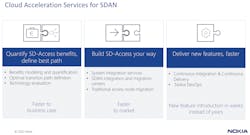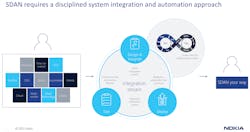SDAN Implementation Best Practices
IT Methodologies and Strategies Work
The fiberization of broadband networks continues apace. Network owners and operators, including many new investors capitalizing on the longevity and solid returns of a fiber network asset, are taking fiber broadband further than ever before.
As networks scale, existing operators find themselves facing increasing complexity, including multiple services, running across multiple technologies, often on assets from different providers. Add to the mix the explosion in subscribers, connected devices, and the ever-increasing service expectations of customers, and operators are facing unprecedented challenges in maintaining operational agility and efficiency.
The arrival of software-defined networking (SDN) in the access network (known as software-defined access networks, or SDAN) provides the solution to these challenges. SDAN creates a highly programmable, automated access network by decoupling the control and forwarding planes, allowing SDN-native and traditional access nodes to be connected to a SDAN controller in the cloud, and freeing devices from having to run complex controls and policies.
The network can then use all kinds of network data to program and automate many operational tasks, such as configurations, provisioning, adds/moves/changes, and even proactive fault finding and resolution.
“Deep IT expertise and cloud capabilities, combined with deep networking expertise, will play a critical role as cloud-based architectures define how fixed broadband access networks are controlled and managed, so it’s inevitable that operators will need to increase their skills and resources in these areas in the mid- to long-term.”
The IT Learning Curve
The downside is that SDAN requires new knowledge and skill sets for operators founded on programming, system integration, cloud and other software skills. In their key themes for 2022, TM Forum found that 74% of telco CEOs are concerned about skills availability, with the situation compounded by a wave of retirements and employee turnover. (Source: https://inform.tmforum.org/research-and-analysis/reports/key-themes-for-2022/)
As a software-based deployment, SDAN is a clear departure from a traditional operator’s comfort zone of hardware-centric projects. Among the knowledge gaps are a deep understanding of how SDAN increases network efficiencies and drives down costs, and how traditional and multi-vendor network architectures can be adapted to a common cloud-based, virtualized operating environment. As no two networks are the same, the transformation path to SDAN is unique to each operator.
At the same time, expert analysis is critical for identifying the best pathways for an operator and quantifying the benefits. Cloud and IT skill sets that encompass the use of microservices, DevOps, software development kits (SDKs), open-source and application programming interfaces (APIs) must be on par with other cloud deployments. These capabilities are needed when migrating to SDAN as then throughout the network life cycle as new functions are created, more complex configurations are deployed, and as new technologies and equipment vendors are introduced to the network.
Transformation Means Acceleration
Getting operators into the cloud also requires a certain level of expertise to meet operators’ unique needs. As such, it can be beneficial to break down the cloud acceleration services into two components: the business and technology consultation, then the system integration.
The consultation part evaluates where SDAN can be best applied to an operator’s network and operating model, and hence ascertain the operational areas that will benefit the most. This will translate into specific operator internal cost savings. For example, across proactive network care, zero-touch device turn-up, or software life cycle management. Typically, operator fault, configuration, accounting, performance, and security (FCAPS) routine tasks are expected to see operating expenses savings of 25-40%. (Source: https://www.nokia.com/blog/sdan-we-do-the-math-you-get-the-money/)
The analysis will be captured in a solution design and deployment plan which includes operational support system (OSS) consultancy and a customer blueprint enlisting service intents, controller configurations and slicing models customized to the operator’s network. This helps speed up decision making for which nodes, technologies or geographies need to be migrated in the near term. It also brings to light the areas where SDAN can accelerate the launch of new technologies, like XGS Passive Optical Networks (PON), or roll out fiber networks in new geographic areas—fast. (See Figure 1.)
SDAN requires seamless integration at both ends—northbound to an operator’s legacy/next-gen OSS and southbound to multivendor optical line terminals (OLTs) and optical network units (ONUs). System integration, therefore, is another evolved IT skill needed on the path to SDAN.
IT techniques and DevOps methodologies, such as automated delivery, deployment, and testing, enable regular software improvements. SDAN updates and new features or services are delivered and tested in a validation environment before being put into production, paving the way towards Continuous Integration and Continuous Delivery (CI/CD). This approach is faster and minimizes rollbacks and service disruption.
With cloud design and integration being relatively new for operators, there are many ways that service providers can provide support. Some areas include designing public cloud solutions on Amazon, Google and Microsoft; configuring services; and installing and integrating the SDAN controller. Global SDAN integration and migration centers allow the reuse of perfected components including intent and test case libraries in commonly recurring SDAN applications, improving the time-to-market for operators.
Incidentally, SDAN can be implemented on a bare metal server, in a private cloud or now in a software-as-a-service (SaaS) model. With SaaS, one doesn’t need the IT expertise, doesn’t need to buy the equipment to run the software, doesn’t need to make a significant up-front investment, and doesn’t need to lose precious time integrating it in the IT environment. (See Figure 2.)
SDAN in Action
To illustrate the benefits of SDAN, let’s look at a couple of real-world examples. A Tier 1 operator in North America recently wanted to accelerate the introduction of G.fast services. SDAN automation meant that many configuration and provisioning tasks became a plug and play affair, reducing or eliminating the need for manual intervention. The provider used lightweight protocol adapters which allowed the operator to maximize the use of its existing IT infrastructure and OSS and got their services online much more quickly. This also accelerated time-to-revenue.
Likewise, in a greenfield fiber-to-the-home (FTTH) deployment for a wholesale network operator, the provider used SDAN to introduce more control and autonomy for its customers and network tenants. With open access to its infrastructure, customers and tenants have been able to customize and tune their virtual network slices based on their needs.
Deep IT expertise and cloud capabilities, combined with deep networking expertise, will play a critical role as cloud-based architectures continue to define how fixed broadband access networks are controlled and managed, so it’s inevitable that operators will need to increase their skills and resources in these areas in the mid- to long-term.
But that shouldn’t be a barrier to the successful adoption of SDAN in the short-term. The faster the move to the cloud, the faster operators can reap the benefits of reduced costs and quicker time-to-revenue with new customers or with new services.
An experienced professional services partner not only brings those skills to a successful migration, but also transfers them to the operator during the process. By pairing up their internal capabilities with cloud acceleration services, operators can speed up their SDAN rollouts and in doing so, enhance network performance, increase service velocity, and significantly improve their bottom line.
About the Author
Eddy Vergauwen
Marketing Director, Fixed Networks Services, Nokia
Eddy Vergauwen is Marketing Director for professional and support services within Fixed Networks Services at Nokia. He has more than 20 years of experience in innovation management, strategy, business development and product management. For more information, email [email protected] or visit https://www.nokia.com/networks/solutions/software-defined-access-networks/. Follow Eddy on Twitter @evergauw. Follow Nokia on Twitter, LinkedIn and Facebook @Nokia.



